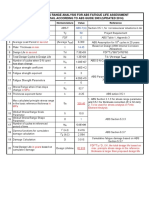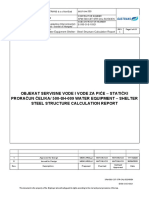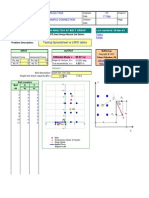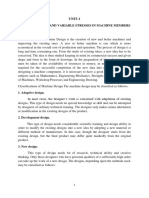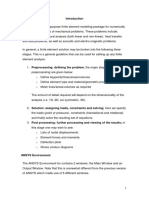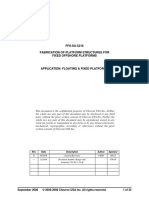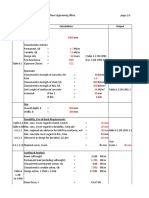Drop Object-Plastic Hinge
Drop Object-Plastic Hinge
Uploaded by
BolarinwaCopyright:
Available Formats
Drop Object-Plastic Hinge
Drop Object-Plastic Hinge
Uploaded by
BolarinwaOriginal Description:
Original Title
Copyright
Available Formats
Share this document
Did you find this document useful?
Is this content inappropriate?
Copyright:
Available Formats
Drop Object-Plastic Hinge
Drop Object-Plastic Hinge
Uploaded by
BolarinwaCopyright:
Available Formats
Activity-Unit
CN
Material Code
xxxx xx
Serial No.
Rev.
xx
xxxxx
Page:
CHK' BY:
APP'D BY:
DATE :
SUBJECT:
DESIGN FOR IMPACT LOADS
(The member is checked assuming that plastic hinges are formed on either side of the impact location with a given angle)
I. IMPACT ENERGY
The work done by an impacting body on member can be either :
- Kinetic energy of moving body at constant velocity:
Ek = 1/2 m v2
- Potential energy of a falling body from height h:
Ep = m g h
Impact body:
mass =
4
tonne
(for boat impact, mass shall include added mass)
Impact case:
Kinetic Energy: velocity =
Ek =
0.50
0.5
m/s
kJ
Potential Energy:
height =
Ep =
1.0
39
m
kJ
II. MEMBER PROPERTIES
Span : L =
Yield Stress: Fy =
Section
Inertia: I (mm4)
Plastic Modulus: Zp (cm3)
Plastic Moment: Mp (kNm)
Stress at plastification: sp (N/mm2)
4.39
250
m
N/mm2
Tubular
OD
356
WT
8
1.32E+08
968.8
242.19
325.4
Beam
IPE120
3
3.2E+06
58.53
14.63
276.3
III. PLASTIC HINGE THEORY
The work done by plastic hinges is given by:
Eh = Mp x N x
- is the rotation of hinges:
say max =
where
5 degrees
- Mp (kNm) is section plastic moment: Mp = Plastic modulus x Yield Stress = Z x Fy
- N depends on the member support condition:
supported
Case 1
Simply supported
Case 2
Fixed-end
Case 3
Cantilever
span
span
span
supported
plastic hinge
N=2
fixed
fixed
plastic hinges
N=4
fixed
plastic hinge
N=1
Activity-Unit
CN
SUBJECT:
xxxx xx
Material Code
xxxxx
Page:
CHK' BY:
APP'D BY:
DATE :
Serial No.
Rev.
xx
Activity-Unit
CN
Material Code
xxxx xx
xxxxx
Page:
CHK' BY:
APP'D BY:
DATE :
SUBJECT:
IV. SUMMARY
Impact case
Member checked:
Case:
p
t
1
(k: kinetic, p: potential)
(t: tubular, b: beam)
242.2
(1: simply supported, 2: fixed-end, 3: cantilever)
V. RESULTS
Assuming
1
member(s) adsorbing impact energy,
work done by plastic hinges is: Eh = 0.175 x Mp = 42.3 kJ
>
Work done by impact load is: Ep = 39 kJ
=>
OK ACCEPT
Actual mid-span deflection: D = L / 2 x tan for simply supported or fixed-end members,
D = L x tan for cantilever member.
D=
0.1920
m
= 192.0 mm
For a point load at centre and plastic hinges forming at ends and/or at centre:
Minimum force P required to reach plasticity and equivalent minimum work W are:
- for supported beam, P = 4 Mp / L =
kN;
W=
kJ
- for fixed-end beam, P = 8 Mp / L =
kN;
W=
kJ
- for cantilever beam,
kN;
W=
kJ
P = Mp / L =
Serial No.
Rev.
xx
Activity-Unit
CN
SUBJECT:
xxxx xx
Material Code
xxxxx
Page:
CHK' BY:
APP'D BY:
DATE :
Serial No.
Rev.
xx
Activity-Unit
Material Code
Serial No.
CN
Page:
CHK' BY:
APP'D BY:
DATE :
SUBJECT:
DESIGN FOR IMPACT LOADS
(The deflection is calculated assuming that plastic hinges are formed on either side of the impact location and that all
impact energy is absorbed by plastic deformation)
I. IMPACT ENERGY
The work done by an impacting body on member can be either :
- Kinetic energy of moving body at constant velocity:
Ek = 1/2 m v2
- Potential energy of a falling body from height h:
Ep = m g h
Impact body:
mass =
4
tonne
(for boat impact, mass shall include added mass)
Impact case:
Kinetic Energy: velocity =
Ek =
0.00
0.0
m/s
kJ
Potential Energy:
height =
Ep =
1.0
39
m
kJ
II. MEMBER PROPERTIES
Span : L =
Yield Stress: Fy =
2.1
250
m
N/mm2
Section
Inertia: I (mm4)
Plastic Modulus: Zp (cm3)
Plastic Moment: Mp (cm3) = Zp x Fy
Stress at plastification: p (N/mm2)
Tubular
OD
356
WT
8
1.32E+08
968.8
242.19
325.4
Beam
IPE500
16
4.8E+08
2107.31
526.83
273.3
III. PLASTIC HINGE THEORY
The work done by plastic hinges is given by:
Eh = Mp x N x
- is the rotation of hinges:
where
- Mp (kNm) is section plastic moment: Mp = Plastic modulus x Yield Stress = Zp x Fy
- N is the number of hinges, and depends on the member support condition:
Case 1
Simply supported
Case 2
Fixed-end
span
supported
span
supported
plastic hinge
N=2
Case 3
Cantilever
fixed
span
plastic hinges
N=4
fixed
fixed
plastic hinge
N=1
Rev.
Activity-Unit
Material Code
CN
SUBJECT:
Page:
CHK' BY:
APP'D BY:
DATE :
Serial No.
Rev.
Activity-Unit
Material Code
CN
Page:
CHK' BY:
APP'D BY:
DATE :
SUBJECT:
IV. SUMMARY
Impact case
Member checked:
Case:
p
b
3
(k: kinetic, p: potential)
(t: tubular, b: beam)
526.8
(1: simply supported, 2: fixed-end, 3: cantilever)
V. RESULTS
Assuming
1
member(s) adsorbing impact energy, and equating
the work done by plastic hinges to the work done by impact load gives:
Eh = Ep =
39
kJ
= Eh / (Mp x N) = 0.074 rad
=
4.3 deg
Actual mid-span deflection: D = L / 2 x tan for simply supported or fixed-end members,
D = L x tan for cantilever member.
D=
0.1567
m
= 156.7 mm
Equivalent force P and equivalent work W are:
- for supported beam, P = 4 Mp / L =
kN;
W=
kJ
- for fixed-end beam, P = 8 Mp / L =
kN;
W=
kJ
kN;
W = 314.5 kJ
- for cantilever beam,
P = Mp / L =
2007
Serial No.
Rev.
Activity-Unit
Material Code
CN
SUBJECT:
Page:
CHK' BY:
APP'D BY:
DATE :
Serial No.
Rev.
You might also like
- 1000 Business IdealsDocument43 pages1000 Business IdealsBolarinwa100% (2)
- BS 2X 33 Two Part EpoxyDocument13 pagesBS 2X 33 Two Part EpoxyBolarinwaNo ratings yet
- Esteem NoteDocument104 pagesEsteem NoteMugiwara No Luffy25% (4)
- Deck Plate Timoshenko TheoreyDocument4 pagesDeck Plate Timoshenko TheoreyPradeep ChitluriNo ratings yet
- Hull Structural Design, Ships With Length Less Than 100 MetresDocument106 pagesHull Structural Design, Ships With Length Less Than 100 MetresShajahan ShagulNo ratings yet
- SN002a (NCCi - Determination of Non-Dimensional Slenderness of I and H Sections)Document11 pagesSN002a (NCCi - Determination of Non-Dimensional Slenderness of I and H Sections)Hamati RamiNo ratings yet
- A3 GeniE Tubular JointDocument60 pagesA3 GeniE Tubular JointFabio OkamotoNo ratings yet
- SS Cse 01Document191 pagesSS Cse 01Senthil SivasubramaniamNo ratings yet
- TCC81 Foundation PadsDocument1 pageTCC81 Foundation PadsReetesh0% (1)
- Dynamic Response of Fixed Offshore Structures Under Environmental LoadsDocument16 pagesDynamic Response of Fixed Offshore Structures Under Environmental LoadsxautraixxxxxxNo ratings yet
- "EMBEDPL2" - Embedment Strength of Stud Plate: Program DescriptionDocument23 pages"EMBEDPL2" - Embedment Strength of Stud Plate: Program DescriptionBolarinwaNo ratings yet
- Ballasting Calculation For The Transportation of PLEMsDocument17 pagesBallasting Calculation For The Transportation of PLEMsBolarinwa100% (1)
- Ffs-su-5216-A - Structural Welding and Inspection For Offshore PlatformsDocument28 pagesFfs-su-5216-A - Structural Welding and Inspection For Offshore PlatformsBolarinwaNo ratings yet
- 101 Ways To Make Money in Africa PDFDocument17 pages101 Ways To Make Money in Africa PDFBolarinwaNo ratings yet
- Civ-su-1.10-A Design and Installation of Living QuartersDocument86 pagesCiv-su-1.10-A Design and Installation of Living QuartersBolarinwa100% (1)
- Civ Du 5009 H Structural Design CriteriaDocument28 pagesCiv Du 5009 H Structural Design CriteriaBolarinwaNo ratings yet
- HA and HB LoadingDocument8 pagesHA and HB LoadingBolarinwa100% (2)
- 101 Ways To Make Money in AfricaDocument17 pages101 Ways To Make Money in AfricaBolarinwa71% (7)
- Explosion Analysis of PiperackDocument146 pagesExplosion Analysis of PiperackSun Rui0% (1)
- Design of Steel Base Plate On Existing Plain ConcreteDocument5 pagesDesign of Steel Base Plate On Existing Plain ConcreteHayman AhmedNo ratings yet
- Frame Foundation-RADocument97 pagesFrame Foundation-RAfrog15No ratings yet
- Kannan RamkumarDocument86 pagesKannan RamkumarAlvin ReynaldiNo ratings yet
- Precast Column - Stability CalculationDocument1 pagePrecast Column - Stability Calculationarif_rubinNo ratings yet
- Probability Analysis of Crane Load and Load Combin PDFDocument14 pagesProbability Analysis of Crane Load and Load Combin PDFAdrian GonzalezNo ratings yet
- Strengthened Joint Design-UpdateDocument4 pagesStrengthened Joint Design-UpdatePhan Trọng NghĩaNo ratings yet
- RR 177Document115 pagesRR 177Mohamed FouadNo ratings yet
- Alexander L. Kielland Ulykken - 30 År Etter - Torgeir Moan (NTNU)Document30 pagesAlexander L. Kielland Ulykken - 30 År Etter - Torgeir Moan (NTNU)Vinícius Ribeiro MachadoNo ratings yet
- Dropped Object To Using The Non-Linear Dynamic AnalysisDocument18 pagesDropped Object To Using The Non-Linear Dynamic AnalysisRaghu MahadevappaNo ratings yet
- SKILLS M03E Execution EN1090Document106 pagesSKILLS M03E Execution EN1090Admir TalicNo ratings yet
- Capacity of Bolts in Bearing Connection Based On AISC-ASD 9th EditionDocument1 pageCapacity of Bolts in Bearing Connection Based On AISC-ASD 9th EditionThiha KyawNo ratings yet
- Fatigue-Mat 4-DeterministicDocument35 pagesFatigue-Mat 4-Deterministicfahmi rajziNo ratings yet
- GeniE UM Vol2Document153 pagesGeniE UM Vol2Jorge HL100% (1)
- Zipline Reference 3Document11 pagesZipline Reference 3Jomo-Rhys GilmanNo ratings yet
- Retaining Wall 03Document13 pagesRetaining Wall 03HanafiahHamzahNo ratings yet
- Q&A - Advanced - Fatigue - Analysis - of - Offshore - Jacket - Tubular - JointsDocument9 pagesQ&A - Advanced - Fatigue - Analysis - of - Offshore - Jacket - Tubular - JointsflcwkNo ratings yet
- Modelling and Analysis of Jacket PlatformDocument11 pagesModelling and Analysis of Jacket PlatformDr R Panneer SelvamNo ratings yet
- Notes: Apply Two Layer of Anti Corrosion Paint Then Apply Third Layer of Semi Glossy Paint. Check Height of Base Assembly For AdjustmentDocument1 pageNotes: Apply Two Layer of Anti Corrosion Paint Then Apply Third Layer of Semi Glossy Paint. Check Height of Base Assembly For AdjustmentkhalidcosmosNo ratings yet
- Lecture 15A.7-Tubular Joints in Offshore StructuresDocument23 pagesLecture 15A.7-Tubular Joints in Offshore StructuresLinh TranNo ratings yet
- Sep 17 Striptheory PitchDocument6 pagesSep 17 Striptheory PitchsibanandarmsNo ratings yet
- Wajac StandardDocument22 pagesWajac StandardajayNo ratings yet
- ABS Fatigue Life Assessment 2014Document1 pageABS Fatigue Life Assessment 2014Fandy SipataNo ratings yet
- نمونه دفترچه محاسبات سازه کششی پارچه ای چادری غشایی افزیر PDFDocument31 pagesنمونه دفترچه محاسبات سازه کششی پارچه ای چادری غشایی افزیر PDFAbed GenaimNo ratings yet
- Along-Wind Dynamic Response: Wind Loading and Structural Response Lecture 12 Dr. J.D. HolmesDocument25 pagesAlong-Wind Dynamic Response: Wind Loading and Structural Response Lecture 12 Dr. J.D. HolmesAy ChNo ratings yet
- Mathcad - Laydown Area Deck PlateDocument3 pagesMathcad - Laydown Area Deck PlatePradeep ChitluriNo ratings yet
- MB 400 Base PlateDocument3 pagesMB 400 Base PlatePeace Rain100% (1)
- Objekat Servisne Vode I Vode Za Piće - Statički Proračun Čelika/ 500-Sh-009 Water Equipment - Shelter Steel Structure Calculation ReportDocument61 pagesObjekat Servisne Vode I Vode Za Piće - Statički Proračun Čelika/ 500-Sh-009 Water Equipment - Shelter Steel Structure Calculation ReporttobiNo ratings yet
- Mathcad - Sandy SoilDocument1 pageMathcad - Sandy SoillsatchithananthanNo ratings yet
- WTG FDN Design Steps1Document9 pagesWTG FDN Design Steps1Ramachandran Sundararaman100% (1)
- Buckling CheckDocument163 pagesBuckling Checkmyusuf_engineerNo ratings yet
- Fatigue of Steel StructuresDocument12 pagesFatigue of Steel Structuresshimic32000No ratings yet
- Bolt Group 01Document4 pagesBolt Group 01Livian TeddyNo ratings yet
- MathCAD - Retaining Wall FoundationDocument6 pagesMathCAD - Retaining Wall FoundationValentinNo ratings yet
- Robustness Analysis of Deteriorating Reinforced Concrete SlabsDocument8 pagesRobustness Analysis of Deteriorating Reinforced Concrete SlabsjeovanNo ratings yet
- Transportation Report Ref For Offshore StructureDocument223 pagesTransportation Report Ref For Offshore StructureGo AaNo ratings yet
- (Corus) SHS Joint Worked ExamplesDocument21 pages(Corus) SHS Joint Worked Examples_at_to_No ratings yet
- Staad Pro Stainless Steel ReportDocument29 pagesStaad Pro Stainless Steel ReportRaviteja Girijala100% (1)
- Gusset StressDocument21 pagesGusset StressSameera RaoNo ratings yet
- Pile Fixity-38Document3 pagesPile Fixity-38Bilal MuhammadNo ratings yet
- Connections UB457 191x98xconnDocument3 pagesConnections UB457 191x98xconnihpeterNo ratings yet
- Installation of Monopiles by Vibrohammers For The Riffgat ProjectDocument14 pagesInstallation of Monopiles by Vibrohammers For The Riffgat ProjectDoThanhTungNo ratings yet
- DANA-Technical Note (TN)Document8 pagesDANA-Technical Note (TN)Samsul Imran BahromNo ratings yet
- Sesam Feature DescriptionDocument207 pagesSesam Feature DescriptionYoungtae KimNo ratings yet
- Pile Foundation Analysis and Design: Geotechnical Engineering Design IiiDocument24 pagesPile Foundation Analysis and Design: Geotechnical Engineering Design IiiFaridNo ratings yet
- Hydromechanics Linear Theory OffshoreDocument8 pagesHydromechanics Linear Theory OffshoreManish ShrivastavaNo ratings yet
- Wind Calc API - RP - 2ADocument1 pageWind Calc API - RP - 2AAdi CahyokoNo ratings yet
- (CDS) Tamra Offshore Wind Farm PJ-160714 PDFDocument41 pages(CDS) Tamra Offshore Wind Farm PJ-160714 PDFnautelNo ratings yet
- DNV CG 0128 2021Document3 pagesDNV CG 0128 2021Aleksandr SavcenkoNo ratings yet
- Mathcad - Column Base Plate CheckDocument12 pagesMathcad - Column Base Plate CheckValentinNo ratings yet
- Machines ElementsDocument72 pagesMachines ElementsAref ManicheNo ratings yet
- Dme BookDocument154 pagesDme BookARUMUGA NAINARNo ratings yet
- BS Civil EngineeringDocument138 pagesBS Civil EngineeringBolarinwa100% (1)
- ANSYS Manual StudentDocument215 pagesANSYS Manual StudentBolarinwaNo ratings yet
- Equipment Numeral Calculator For A ShipDocument16 pagesEquipment Numeral Calculator For A ShipBolarinwa100% (1)
- Civ-su-1.28-A Helidecks On Offshore InstallationsDocument12 pagesCiv-su-1.28-A Helidecks On Offshore InstallationsBolarinwaNo ratings yet
- Ffs-pu-5116-A-transportation of Cargo by Barge or ShipDocument28 pagesFfs-pu-5116-A-transportation of Cargo by Barge or ShipBolarinwa100% (1)
- Ffs Su 5221Document12 pagesFfs Su 5221BolarinwaNo ratings yet
- Crosby Shackles G-2130 PDFDocument2 pagesCrosby Shackles G-2130 PDFBolarinwaNo ratings yet
- Ffs Su 5218Document33 pagesFfs Su 5218BolarinwaNo ratings yet
- Ffs Su 5221Document12 pagesFfs Su 5221BolarinwaNo ratings yet
- Gen-Su-5227 - Units of MeasurementDocument4 pagesGen-Su-5227 - Units of MeasurementBolarinwaNo ratings yet
- StruCalc 80 ManualDocument124 pagesStruCalc 80 ManualBolarinwaNo ratings yet
- Civ-Su-6001-C - Design of BuildingsDocument37 pagesCiv-Su-6001-C - Design of BuildingsBolarinwaNo ratings yet
- Mac-Su-7.01 - Offshore Lattice Boom Pedestal CranesDocument31 pagesMac-Su-7.01 - Offshore Lattice Boom Pedestal CranesBolarinwaNo ratings yet
- Sketchometry Book enDocument20 pagesSketchometry Book enBolarinwaNo ratings yet
- Equipment Data Sheet Mts Goldhofer - PubDocument1 pageEquipment Data Sheet Mts Goldhofer - PubBolarinwaNo ratings yet
- Top Head Lug & Tail Lug DesignDocument30 pagesTop Head Lug & Tail Lug DesignBolarinwaNo ratings yet
- Python Scripting Tutorial - FreeCAD DocumentationDocument11 pagesPython Scripting Tutorial - FreeCAD DocumentationBolarinwaNo ratings yet
- Lifting BeamsDocument21 pagesLifting BeamsBolarinwaNo ratings yet
- Design of ConcreteDocument36 pagesDesign of ConcreteDenden Dermawan100% (3)
- Autodesk Nastran For Inventor: Unlocking Nonlinear Analysis: Learning ObjectivesDocument17 pagesAutodesk Nastran For Inventor: Unlocking Nonlinear Analysis: Learning ObjectivesGilmar MenegottoNo ratings yet
- The Structural Behaviour of Castellated BeamsDocument152 pagesThe Structural Behaviour of Castellated BeamsAdnan NajemNo ratings yet
- Structural Design of Buried Flexible Pipes For Trenchless InstallationsDocument14 pagesStructural Design of Buried Flexible Pipes For Trenchless InstallationsVanCauNguyenNo ratings yet
- RC BeamDocument36 pagesRC BeamMuhamad Amirul Md. RazdiNo ratings yet
- LECTURE 6-PSC4 - DeflectionDocument17 pagesLECTURE 6-PSC4 - DeflectionAdam Salimi100% (1)
- Assignment 2Document10 pagesAssignment 2Ye Min ThantNo ratings yet
- Deflection of A Flexible Pipe Using The Modified Iowa Formula - FlowDocument3 pagesDeflection of A Flexible Pipe Using The Modified Iowa Formula - Flowwesm wesmNo ratings yet
- Piperack CalculationDocument252 pagesPiperack CalculationUDayNo ratings yet
- 20eu254 - Dub13 Tate Hac Submittal (Grid)Document10 pages20eu254 - Dub13 Tate Hac Submittal (Grid)Mostapha SoubraNo ratings yet
- Mechanical Engineering Tools For ExcelDocument223 pagesMechanical Engineering Tools For Excelsd731No ratings yet
- Analysis of Indeteminate StructuresDocument11 pagesAnalysis of Indeteminate StructuresAbbasabbasiNo ratings yet
- Bs5950 Calculation Decking SheetDocument6 pagesBs5950 Calculation Decking SheetKho C Ahl100% (1)
- Tedds Engineering Library (AU)Document79 pagesTedds Engineering Library (AU)CSEC Uganda Ltd.No ratings yet
- CE-4005 B.E. IV Semester Structural Analysis - I: Roll NoDocument2 pagesCE-4005 B.E. IV Semester Structural Analysis - I: Roll NoMOhsin IshNo ratings yet
- Text BooksDocument1 pageText BooksPraveen KumarNo ratings yet
- In-Plane Stability of Portal FramesDocument222 pagesIn-Plane Stability of Portal Frameschoriya007No ratings yet
- Strength of Materials: B.E. (Civil Engineering) Third Semester (C.B.S.)Document26 pagesStrength of Materials: B.E. (Civil Engineering) Third Semester (C.B.S.)JayNo ratings yet
- Design Basis Report FgsDocument17 pagesDesign Basis Report Fgsarjun100% (1)
- Civil Engineering Department Politeknik Ungku OmarDocument10 pagesCivil Engineering Department Politeknik Ungku OmarasyrafNo ratings yet
- Ce 3 Structural Theory Lecture 2 Beam Deflections Lecturer: Engr. MmrtatingDocument3 pagesCe 3 Structural Theory Lecture 2 Beam Deflections Lecturer: Engr. MmrtatingJessa Clarisse CrisostomoNo ratings yet
- Loadman and Benkelman CompDocument38 pagesLoadman and Benkelman Compchaitanya mycherlaNo ratings yet
- Blutex - Part 2 - Slab Design - One Way - 2021 - 05 - 01Document24 pagesBlutex - Part 2 - Slab Design - One Way - 2021 - 05 - 01Niraj100% (1)
- Beam Bending LabDocument23 pagesBeam Bending LabJustin TinkerNo ratings yet
- 1994 Composite Beam Design ExampleDocument10 pages1994 Composite Beam Design Examplebalamurali031100% (2)
- Release Notes: 8.5.13.0 (27 Sept 2013)Document104 pagesRelease Notes: 8.5.13.0 (27 Sept 2013)Allen YaoNo ratings yet
- SEDU Dynamic Analysis Procedure PDFDocument36 pagesSEDU Dynamic Analysis Procedure PDFgabelendaNo ratings yet
- TOS 02 Student'sDocument2 pagesTOS 02 Student'sCed CalzadoNo ratings yet
- Tower Foundation - Chapter 5Document45 pagesTower Foundation - Chapter 5kayshephNo ratings yet









































